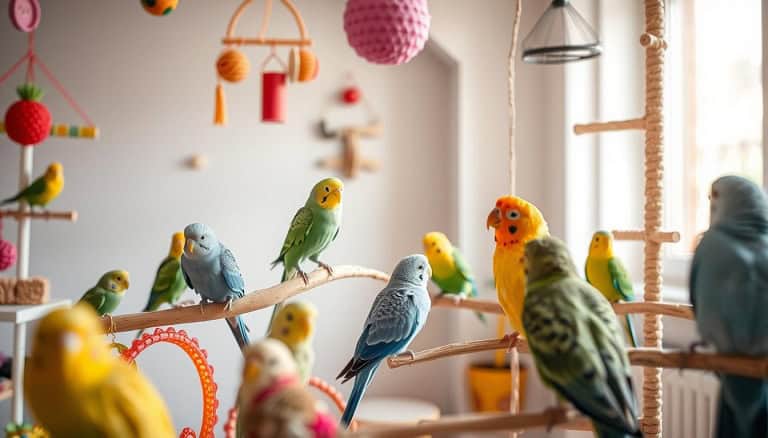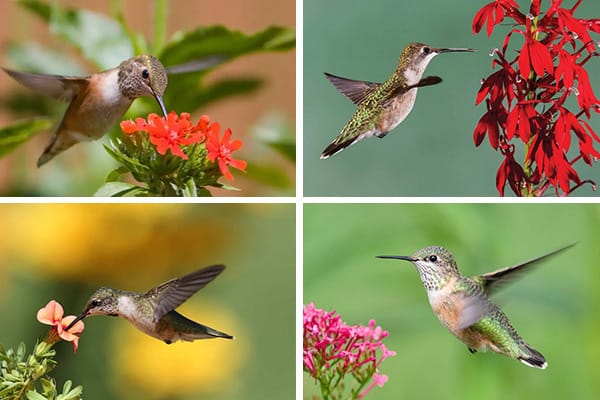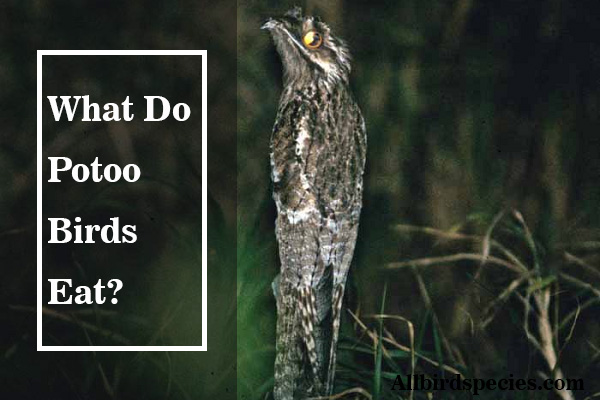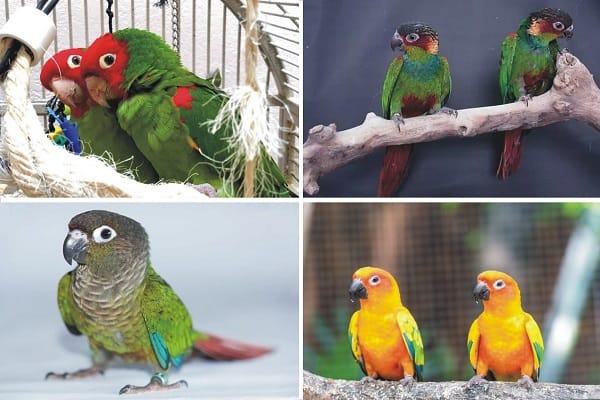Tamed Budgies Cockatiels and Lovebirds: Is It Legit?
Did you know that Tamed budgies, cockatiels, and lovebirds are top picks for families? They are great for kids because they are social and fun. But can you really tame them? Let’s explore if it’s possible to train these birds.
Let’s find out if taming these birds is real or just a dream. We’ll look at what it takes to bond with them. You can have a wonderful time with your bird friends by learning their behaviors.
Understanding Tamed Budgies, Cockatiels, and Lovebirds
Knowing about pet birds means learning about their special traits. Tamed budgies are full of life and love to play. They are a bit shy but love to be around people. They need lots of fun things to do and can live up to 15 years.
Cockatiels are known for being gentle. They are easy to handle and can even whistle. They bond strongly with their owners and can live up to 20 years. Their friendly nature makes them a favorite among bird lovers.

Lovebirds are full of energy and love to show affection. They are small but very lively. They can live up to 20 years if they get enough attention. Their playful ways make them great companions.
| Species | Lifespan | Characteristics |
|---|---|---|
| Budgies | 10-15 years | Skittish, social, playful |
| Cockatiels | 15-20 years | Gentle, affectionate, whistlers |
| Lovebirds | 12-20 years | Affectionate, energetic, lively |
The Importance of Taming Pet Birds
Taming your pet bird makes your bond stronger and more fun. Birds love to be around others, and taming them brings joy. It’s key to understand this to handle the duties of owning a pet.
Benefits of Taming Your Bird
One big plus is that your bird becomes more social. They start to enjoy spending time with you. Taming also lowers their stress and makes them feel safer.
Challenges You May Encounter
But taming isn’t always easy. You’ll need patience, time, and to know how birds act. Birds need 2-3 hours of your time each day to bond well. Knowing your bird’s learning pace helps you face these challenges.
How Budgies, Cockatiels, and Lovebirds Differ
Knowing the differences between budgies, cockatiels, and lovebirds helps you choose the right bird. Each has its own budgie features, cockatiel appearance, and lovebird behavior. These traits affect how you care for and train them.
Physical Characteristics
Let’s look at the physical traits of each bird:
| Bird Type | Weight | Length | Lifespan | Key Features |
|---|---|---|---|---|
| Budgies | 1 ounce | 6 to 8 inches | 7 – 15 years | Colorful feathers in shades like neon green, yellow, and blue, with black markings. |
| Cockatiels | 3 ounces | 12 to 13 inches | 15 – 20 years | Gray body with orange cheek spots, yellow crown in males, and a long tail. |
| Lovebirds | 2 ounces | 5 to 6 inches | 20+ years | Predominantly green with an orange head and blue accents, known for their vibrant personalities. |
Behavioral Traits
Now, let’s explore their behavioral comparisons:
- Budgies: Tend to be playful and curious, but can also be timid. Training and socialization are essential to foster their affectionate side.
- Cockatiels: Known for their friendly and sociable nature, cockatiels enjoy interacting with people and other birds and become more playful when socialized properly.
- Lovebirds: These birds exhibit boldness and a quirky sense of humor. Their energetic lovebird behavior keeps owners entertained but needs consistent engagement to thrive.
Understanding these traits prepares you for bird ownership and enhances the connection you will build with your new companion. Owning any of these birds requires dedication, patience, and a desire to adapt to their specific personalities.
Taming Techniques for Budgies
Taming budgies requires dedication and knowledge of their nature. Start early to build a strong bond. Talk to your birds and gently touch them to gain their trust.
Use positive rewards to encourage them. Treats help them want to learn and interact more.
Early Interactions and Bonding
Start by making a routine. Spend time with your budgies every day. This helps them feel safe and builds a strong bond.
For new birds, start with a clipped one to avoid accidents. Be patient and loving. These qualities are key in taming budgies.
Cage Training Tips
Training in a cage is important. Make a safe area for them to learn. Use a quiet room for training to avoid distractions.
Train one bird at a time. Teach them to “step up” first. Then, you can train them together. Here are some tips:
- Train in short sessions, often. This keeps them focused.
- Teach them to stay and return to their cage. This reduces stress.
- Know your birds’ unique challenges. For example, 70% of owners struggle to build trust for touching.
Good bird cage training strengthens your bond. It makes taming your budgies a joy for both of you.
| Training Strategy | Description | Benefits |
|---|---|---|
| Daily Interaction | Talking and engaging during routine activities | Builds trust and comfort |
| Individual Training | Focus on one bird at a time for the basic commands | Increases learning efficiency |
| Short Sessions | Keep training sessions brief and frequent | Maintains bird’s attention, increases retention |
| Quiet Environment | Conduct training in a distraction-free space | Promotes focus and reduces stress |
Taming Techniques for Cockatiels
Cockatiels are known for their lively personalities and affectionate nature. Taming these birds requires patience and care. Creating safe bird environments is key to their comfort and familiarity. A secure space helps cockatiels relax, making taming easier.
Creating a Safe Environment
Creating a nurturing and calm space is crucial for cockatiel taming. Your cockatiel may be sensitive to sudden changes, so keeping their environment consistent is vital.
Here are some important aspects for safe bird environments:
- Use the same space for their cage to avoid confusion.
- Avoid loud noises and sudden movements that may startle them.
- Provide enriching toys and perches to encourage exploration.
Give your cockatiel time to adjust to their environment. Gradually introduce interactions, ensuring they feel secure and comfortable.
Strategies for Building Trust
Effective trust-building techniques can greatly improve your relationship with your cockatiel. Engaging in daily routines helps your bird feel more at ease. Consider the following strategies:
- Respect their space, allowing them to approach you when they feel ready.
- Use consistent routines for feeding and interaction to foster predictability.
- Introduce handling gradually, using treats to create positive experiences.
Building trust takes time. Progress may be slow, especially if your cockatiel has been frightened before. By staying patient and dedicated, you will build a lasting, affectionate relationship.
Taming Techniques for Lovebirds
Understanding a lovebird’s personality is key to taming them. These birds are curious and lively. Their bold nature makes taming them a bit tough, especially earning their trust.
Every lovebird is unique, with its own quirks. These quirks can guide how you train and bond with them.
Understanding Their Personality
Lovebirds love to be around people and show their feelings. Being patient and aware of their moods is important. Start by watching how they act during playtime.
This helps you see if they feel comfortable and want to play with you.
Engagement Through Play
Playing with lovebirds is a great way to tame them. They love to play with toys, climb, and play games with you. Adding playtime to your routine makes it fun and builds trust.
Benefits of Having Multiple Birds Together
Having more than one bird at home can make it lively. It’s good for their happiness. Birds need friends to act naturally and have fun together.
Social Interaction and Mental Stimulation
Birds that live together stay active and happy. They talk and play, which helps them feel less lonely. The main benefits are:
- Increased activity levels
- Improved communication skills
- Reduction in destructive behaviors
- Enhanced confidence in their environment
These activities make them feel safe and happy.
Potential for Bonding Between the Birds
Birds can become close friends, which makes them happier. They groom and play with each other. To help them bond, remember:
- Selecting birds of similar sizes and temperaments
- Providing ample space in their living area
- Introducing them gradually to avoid territorial disputes
This friendship makes them and you happy. It’s all about making them feel loved and engaged.
Issues to Consider When Choosing a Pet Bird
Deciding to get a pet bird is a big choice. Each bird needs special care that takes a lot of time. Knowing bird care requirements is key to a good bond with your bird. You must also think about your home and lifestyle to handle pet noise levels.
Time Commitment and Care Requirements
Having a bird means you need to give it lots of attention. Important bird care requirements include:
- Daily feeding and refreshing of water
- Regular cleaning of cages and play areas
- Social interaction and mental stimulation to prevent loneliness
- Veterinary care and health assessments
Different birds have different needs. For example, budgerigars and cockatiels love to be around people. Finches might like less interaction. Knowing these needs helps keep your bird happy and healthy.
Noise Levels and Space Considerations
When choosing a pet bird, think about how loud they are. Some birds are very vocal, which might not be right for every home. For example:
| Bird Species | Pet Noise Levels | Space Requirements |
|---|---|---|
| Budgerigars | Moderate | Small cage, but needs time outside |
| Cockatiels | Moderate to Loud | Medium-sized cage, requires flight space |
| Lovebirds | Loud | Need larger enclosures for activity |
| Finches | Quiet | Small cage, best in pairs or groups |
Knowing about bird noise helps you see how it might affect your home. Getting ready for a pet bird means thinking about their noise and space needs.
Common Misconceptions about Taming Birds
Taming birds is often filled with myths and misunderstandings. Many think all birds can be tamed easily. But, the truth is, it depends on the bird’s upbringing and socialization.
Hand-raised birds tend to be more tame. Birds that didn’t have early interactions might not bond as well.
Are All Birds Capable of Being Tamed?
Many people think any bird can become a friendly pet with enough effort. While some species like budgies, cockatiels, and lovebirds are easier to tame, results can vary. It’s important to know that not all birds will bond the same way.
For example, spending about an hour a day talking to your budgie near its cage for two weeks can help. This can start building trust and a bond.
Is Taming Worth the Effort?
There’s a lot of debate about whether taming birds is worth it. It takes patience, consistent interaction, and understanding of bird behavior. Creating a safe and nurturing environment is key.
Actions that scare your bird, like grabbing or chasing, should be avoided. Instead, focus on positive experiences and patience. The rewards of a strong bond with your bird can make all the effort worth it.
| Aspect | Details |
|---|---|
| Minimum Cage Size for Budgies | 18x18x18 inches |
| Daily Interaction Time | 1 hour near the cage for 2 weeks |
| Signs of a Healthy Bird | Active, preening, vocalizing |
| Common Health Issues | Respiratory disease, obesity, psittacosis |
| Recommended Play Stand Setup | 3-4 perches at different levels, toys, food, water |
Success Stories from Bird Owners
Bird ownership can make life richer and more fulfilling. Many people share their stories of joy and growth with their birds. These tales show how deep bonds can form between humans and their feathered friends.
Positive Experiences with Tamed Birds
Many bird owners see big changes in their pets’ behavior. They thank experts like Barbara Heidenreich for their help. A 100% positive feedback rate shows how much people appreciate the training.
People see big changes in just one session. Using positive methods works best. This approach makes 100% of people happy with their bird’s progress.
These stories often talk about better relationships with birds. Improving behavior is a big theme. It shows how caring for birds can make our lives better.
Lessons Learned from Bird Ownership
Being a bird owner teaches us a lot. Hands-on training is often more effective than just knowing about it. People learn a lot from workshops and change how they train their birds.
This new understanding helps them connect more with their pets. Learning about bird behavior is key to a happy experience. It makes caring for birds rewarding.
| Workshop Insights | Statistics |
|---|---|
| Attendees Reporting Satisfaction | 100% |
| Progress Rate in Step-Up Training | Significant Improvement in One Session |
| Positive Outcomes from Positive Reinforcement | 100% of Attendees |
| Bird Owners Recommending Products | 100% |
| Testimonials on Improved Relationships | Common Theme Throughout |
| Inspiration Found in Workshops | 100% of Participants |
| Shift in Understanding Parrot Training | 100% of Seminar Attendees |
| Positive Reinforcement Success Stories | Multiple Testimonials |
| Effective Hands-On Training Perception | High Satisfaction Rate |
| Subscribers Finding Good Bird Magazine Useful | 100% |
Bird ownership is filled with success stories and lessons. By learning and caring for birds, we can build strong bonds. This enriches our lives in many ways.
Tamed Budgies Cockatiels and Lovebirds: Is It Legit or Not
Is it real to tame birds like budgies, cockatiels, and lovebirds? It depends on a few key things. Knowing their special traits helps us see the tamed budgies cockatiels lovebirds benefits. It also keeps our birds happy and healthy.
Cockatiels can live up to 15 to 25 years with the right care. This means a big commitment. Before getting one, think about your lifestyle and if you’re ready for a long-term pet.
The cost for hand-fed cockatiels is usually between $40 to $130. This is a fair price for many bird lovers.
Lovebirds cost about $80 in places like Boston. They are more active and can be louder than cockatiels. But, they are very playful and can form strong bonds with their owners.
Some people might find lovebirds a bit challenging because they can be stubborn. Knowing this helps ensure a good relationship with them.
Cockatiels are great for beginners because they are friendly and not too loud. Males might make more noise, but they are very loving. This makes them popular pets.
| Bird Type | Average Lifespan | Typical Price | Behavior |
|---|---|---|---|
| Cockatiels | 15-25 years | $40 – $130 | Personable, affectionate, and moderately vocal |
| Lovebirds | Approx. 10-15 years | $80 | Active, playful, and can be nippy |
| Budgies | Approx. 5-10 years | Varies widely | Social and playful, usually less vocal than lovebirds |
The legitimacy of tamed birds depends on the owner’s commitment. By creating a caring and interactive space, you can have a wonderful time with your birds.

Expert Advice on Taming Birds
Taming birds is a journey filled with learning and bonding. Getting advice from avian experts can make it better. They say to be patient and consistent with your birds. Every bird is different, so taming is a personal journey for each owner.
Recommendations from Avian Specialists
Avian specialists give these tips for taming birds:
- Be Patient: Birds need time to get used to and trust their owners.
- Consistent Interaction: Regular, gentle handling builds a strong bond.
- Positive Reinforcement: Use treats and praise to encourage good behavior.
- Cage Training: Let your bird explore outside its cage safely.
- Observe Behavior: Knowing your bird’s needs helps in training.
Resources for Bird Owners
Using good bird owner resources can improve your taming skills. Here are some great resources:
| Resource Type | Description |
|---|---|
| Books | Books like *The Parrot Who Thought He Was a Dog* share insights on training and bonding. |
| Online Communities | Websites like Avian Avenue have forums for sharing taming tips with other owners. |
| Video Tutorials | YouTube has many videos from experts showing how to tame birds effectively. |
| Local Avian Specialists | Talking to experts can give you advice tailored to your bird’s needs. |
Bottom Line
Taming budgies, cockatiels, and lovebirds is a rewarding journey that improves your life and theirs. Learning about their behaviors, social needs, and health is key. This leads to fun interactions and strong bonds.
A happy and safe bird is more likely to thrive. This is because they trust you more. Creating a caring environment is very important.
This article taught us important lessons about bird ownership. Sadly, 75% of parrots in captivity are not well cared for, which shows how crucial proper care is.
By giving your bird the right care, you can greatly improve its life. They can live for 20-40 years. It is also important to let them out of their cages for at least two hours a day.
Our Recomended Articles To Read:-
- Don’t Let Birds Next Their Nest Meaning
- Do Cats Eat Recently Dead Birds
- Top 10 Small Birds with Red Beaks
- Types of Cranes in Michigan
- Are Birds Just Flying Mammals in Disguise
Frequently Asked Questions
What are the distinct characteristics of budgies, cockatiels, and lovebirds?
Budgies are full of energy and can be a bit shy. Cockatiels are gentle and need the right home to be happy. Lovebirds are very social and loving, making great pets.
Why is taming important for pet birds?
Taming makes your bird happier and more interactive. Tamed birds are less stressed and can talk to you better. This makes them healthier and happier.
What challenges might I face when taming my bird?
It takes patience and time to tame a bird. You need to spend 2-3 hours a day with them, and understanding their behavior is also key.
What are some effective taming techniques for budgies?
Start by talking to and gently touching your budgie. Use positive rewards and create a safe space in their cage. This helps them feel less stressed.
How can I create a safe environment for cockatiels?
Keep their area calm and give them lots of time to interact. Use routines and treats to build trust. This makes taming easier.







